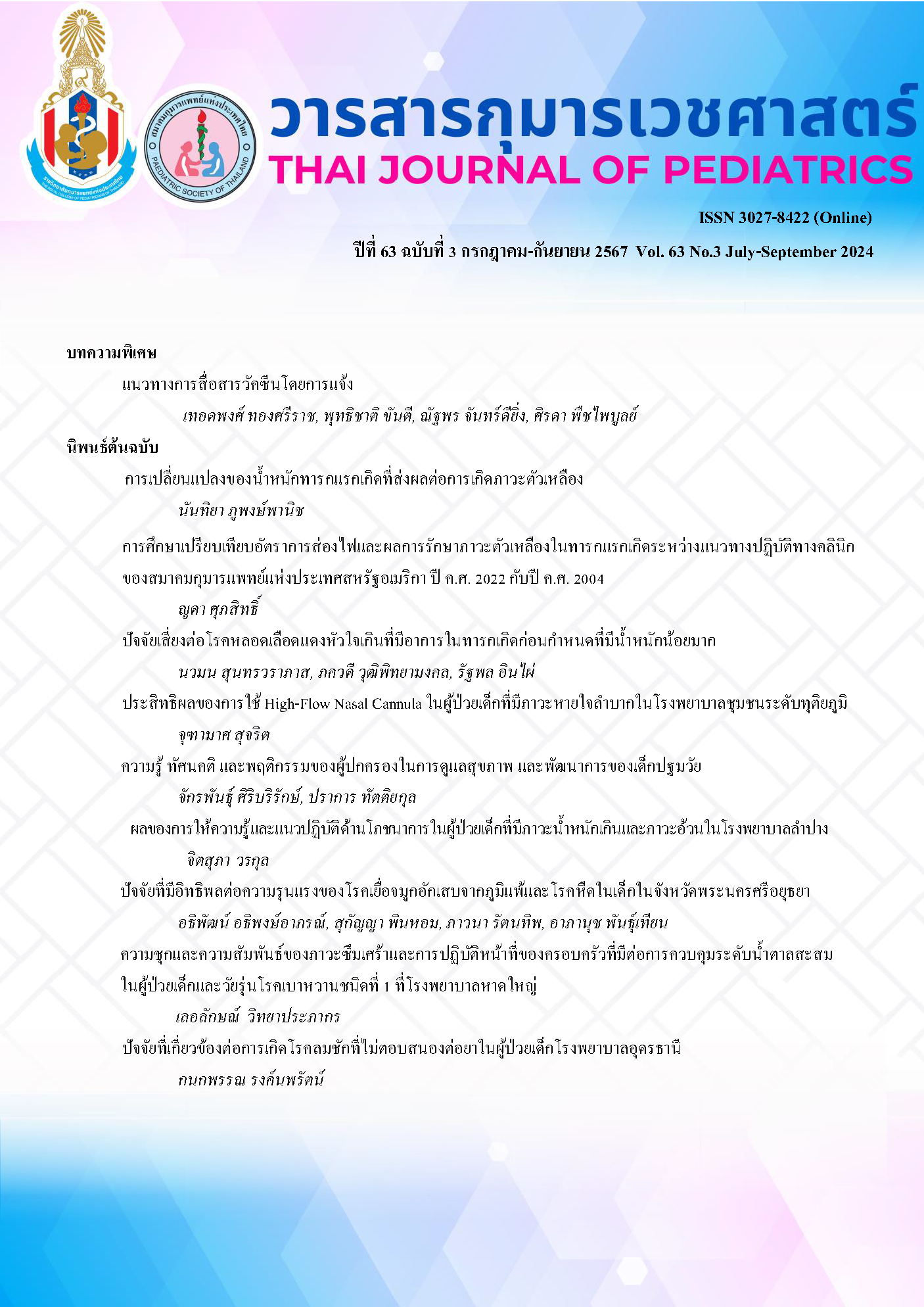Percentage of body weight loss for predicting jaundice in term newborn infants
Keywords:
Body weight loss, Jaundice, hyperbilirubinemia, rebound neonatal jaundice, Suboptimal intake jaundice, Term infantAbstract
Background: Various problems cause neonatal jaundice. One of the common causes is suboptimal intake jaundice, which is caused by inadequate intake resulting in increased enterohepatic circulation and leading to hyperbilirubinemia. Singburi Hospital, which advocates exclusive breastfeeding, has observed a rise in hyperbilirubinemia cases necessitating prolonged hospital stays.
Objective: To explore the correlation between body weight loss and hyperbilirubinemia resulting in jaundice and to determine the prevalence of jaundice at Singburi hospital.
Methods: Term infants born between January 1, 2022 and March 31, 2023 were included in this retrospective descriptive study. Baseline characteristics were collected to evaluate risk factors associated with hyperbilirubinemia, including percentage of weight loss, and levels of unconjugated bilirubin. Analyze the data using independent t-test statistics. If any factor has a p value < 0.05, it will be further to analyzed in multiple logistic regression. Also, the optimal cutoff point between percentage body weight loss and hyperbilirubinemia was determined by utilizing a Receiver Operating Characteristic (ROC) curve.
Results: This study involved 707 term infants, including 364 males and 343 females. The prevalence of jaundice was 9.1% (64 patients). From ROC, the optimal cutoff point for predicting jaundice at 24 hours after birth was 4% body weight loss, which was statistically significant. [p=0.0014, Odds ratio; OR 2.09, AUC 0.559 (95%CI 0.481-0.637)].
Conclusion: This research can be used to develop guidelines for preventing jaundice in term newborns by promoting early successful breastfeeding management in the future.
Downloads
References
Ansong-Assoku B, Shah SD, Adnan M, Ankola PA. Neonatal Jaundice. In: StatPearls [Internet]. Treasure Island (FL): StatPearls Publishing; 2023 [cited 2023 May 24]. Available from: http://www.ncbi.nlm.nih.gov/books/NBK532930/
Kemper AR, Newman TB, Slaughter JL, Maisels MJ, Watchko JF, Downs SM, et al. Clinical Practice Guideline Revision: Management of hyperbilirubinemia in the newborn infant 35 or more weeks of gestation. Pediatrics. 2022;150(3):e2022058859.
Gartner LM. Breastfeeding and jaundice. J Perinatol Off J Calif Perinat Assoc. 2001;21:S25-9; discussion S35-39.
Diala UM, Usman F, Appiah D, Hassan L, Ogundele T, Abdullahi F, et al. Global prevalence of severe neonatal jaundice among hospital admissions: A systematic review and meta-analysis. J Clin Med. 2023;12.3738.
Prasarnphanich T, Somlaw S. The value of routine bilirubin screening to detect significant hyperbilirubinemia in Thai healthy term newborns. J Med Assoc Thail Chotmaihet Thangphaet. 2007;90:925–30.
วรรณพร วาณิชยเศรษฐกุล . ความชุกและปัจจัยที่สัมพันธ์กับภาวะตัวเหลืองในทารกแรกเกิดคลอดครบกำหนด ในโรงพยาบาลปทุมธานี. วารสารแพทย์เขต 4-5. 2022;41:633–44.
Chen CF, Hsu MC, Shen CH, Wang CL, Chang SC, Wu KG, et al. Influence of breast-feeding on weight loss, jaundice, and waste elimination in neonates. Pediatr Neonatol. 2011;52:85–92.
Chang RJ, Chou HC, Chang YH, Chen MH, Chen CY, Hsieh WS, et al. Weight loss percentage prediction of subsequent neonatal hyperbilirubinemia in exclusively breastfed neonates. Pediatr Neonatol. 2012;53:41–4.
Yang WC, Zhao LL, Li YC, Chen CH, Chang YJ, Fu YC, et al. Bodyweight loss in predicting neonatal hyperbilirubinemia 72 hours after birth in term newborn infants. BMC Pediatr. 2013;13:145.
อรภัทร วิริยอุดมศิริ. การเปลี่ยนแปลงน้ำหนักที่อายุ 24, 48 ชั่วโมงหลังคลอดสำหรับทำนาย ภาวะ breast feeding jaundice ในกลุ่มทารกแรกเกิดครบกำหนด. วารสารการแพทย์โรงพยาบาลศรีสะเกษ สุรินทร์ บุรีรัมย์. 2018;33:11–21.
Prachukthum S, Tanprasertkul C, Intarakhao S. Does weight loss predict hyperbilirubinemia requiring readmission for phototherapy in term infants? Sci Technol Asia. 2020;25:11–8.
Eidelman AI, Schanler RJ, Johnston M, Landers S, Noble L. Breastfeeding and the Use of Human Milk. Pediatrics. 2012;129:e827–41.
Kellams A, Harrel C, Omage S, Gregory C, Rosen-Carole C. ABM Clinical Protocol #3: Supplementary feedings in the healthy term breastfed neonate, Revised 2017. Breastfeed Med Off J Acad Breastfeed Med. 2017;12:188–98.
Subcommittee on Hyperbilirubinemia. Management of hyperbilirubinemia in the newborn infant 35 or more weeks of gestation. Pediatrics. 2004;114:297–316.
Flaherman VJ, Maisels MJ, Brodribb W, Noble L, Brent N, Bunik M, et al. ABM Clinical Protocol #22: Guidelines for management of jaundice in the breastfeeding infant 35 weeks or more of gestation—Revised 2017. Breastfeed Med. 2017;12:250–7.
Flaherman VJ, Schaefer EW, Kuzniewicz MW, Li SX, Walsh EM, Paul IM. Early weight loss nomograms for exclusively breastfed newborns. Pediatrics. 2015;135:e16-23.
Salas AA, Salazar J, Burgoa CV, De-Villegas CA, Quevedo V, Soliz A. Significant weight loss in breastfed term infants readmitted for hyperbilirubinemia. BMC Pediatr. 2009;9:82.
Indriyani SAK, Retayasa IW, Surjono A, Suryantoro P. Percentage birth weight loss and hyperbilirubinemia during the first week of life in term newborns. Paediatr Indones. 2009;49:149-54.
Maisels MJ, Gifford K. Normal serum bilirubin levels in the newborn and the effect of breast-feeding. Pediatrics. 1986;78:837–43.
Downloads
Published
How to Cite
Issue
Section
License
Copyright (c) 2024 The Royal College of Pediatricians Of Thailand

This work is licensed under a Creative Commons Attribution-NonCommercial-NoDerivatives 4.0 International License.



